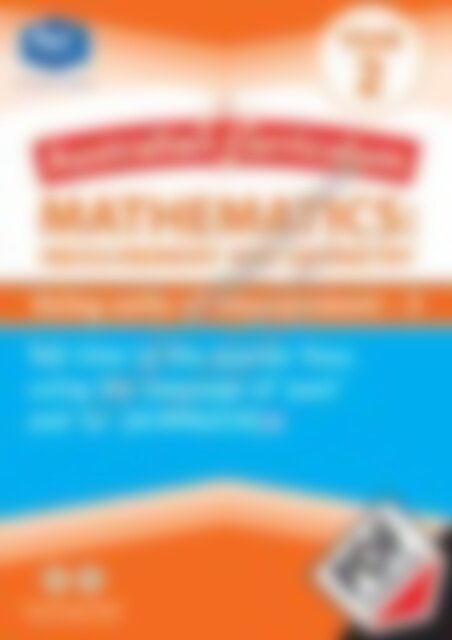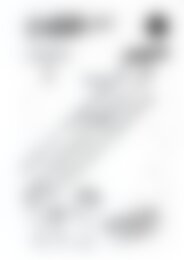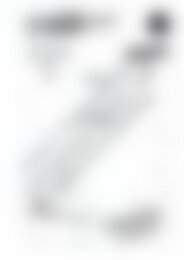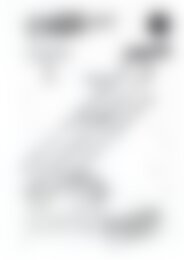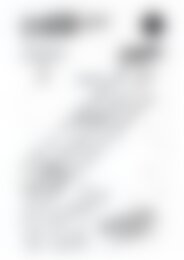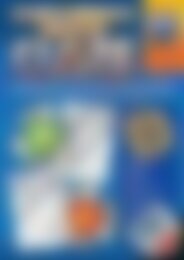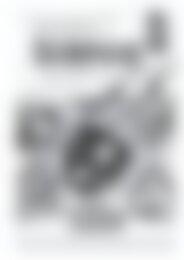RIC-20140 ACM Measurement and Geometry (Yr 2) Using units of measurement 3
You also want an ePaper? Increase the reach of your titles
YUMPU automatically turns print PDFs into web optimized ePapers that Google loves.
©R.I.C. Publications<br />
Low Resolution Images<br />
Display Copy
Australian Curriculum Mathematics<br />
resource book: <strong>Measurement</strong> <strong>and</strong> <strong>Geometry</strong><br />
(Year 2)<br />
Published by R.I.C. Publications ® 2013<br />
Copyright © Linda Marshall 2013<br />
<strong>RIC</strong>– <strong>20140</strong><br />
Titles in this series:<br />
Australian Curriculum Mathematics resource book:<br />
<strong>Measurement</strong> <strong>and</strong> <strong>Geometry</strong> (Foundation)<br />
Australian Curriculum Mathematics resource book:<br />
<strong>Measurement</strong> <strong>and</strong> <strong>Geometry</strong> (Year 1)<br />
Australian Curriculum Mathematics resource book:<br />
<strong>Measurement</strong> <strong>and</strong> <strong>Geometry</strong> (Year 2)<br />
Australian Curriculum Mathematics resource book:<br />
<strong>Measurement</strong> <strong>and</strong> <strong>Geometry</strong> (Year 3)<br />
Australian Curriculum Mathematics resource book:<br />
<strong>Measurement</strong> <strong>and</strong> <strong>Geometry</strong> (Year 4)<br />
Australian Curriculum Mathematics resource book:<br />
<strong>Measurement</strong> <strong>and</strong> <strong>Geometry</strong> (Year 5)<br />
Australian Curriculum Mathematics resource book:<br />
<strong>Measurement</strong> <strong>and</strong> <strong>Geometry</strong> (Year 6)<br />
All material identified by is material subject to<br />
copyright under the Copyright Act 1968 (Cth) <strong>and</strong> is owned<br />
by the Australian Curriculum, Assessment <strong>and</strong> Reporting<br />
Authority 2013.<br />
For all Australian Curriculum material except<br />
elaborations: This is an extract from the Australian<br />
Curriculum.<br />
Elaborations: This may be a modified extract from the<br />
Australian Curriculum <strong>and</strong> may include the work <strong>of</strong> other<br />
authors.<br />
Disclaimer: ACARA neither endorses nor verifies the<br />
accuracy <strong>of</strong> the information provided <strong>and</strong> accepts no<br />
responsibility for incomplete or inaccurate information. In<br />
particular, ACARA does not endorse or verify that:<br />
• The content descriptions are solely for a particular year<br />
<strong>and</strong> subject;<br />
• All the content descriptions for that year <strong>and</strong> subject<br />
have been used; <strong>and</strong><br />
• The author’s material aligns with the Australian<br />
Curriculum content descriptions for the relevant year<br />
<strong>and</strong> subject.<br />
You can find the unaltered <strong>and</strong> most up to date version <strong>of</strong><br />
this material at http://www.australiancurriculum.edu.au/<br />
This material is reproduced with the permission <strong>of</strong> ACARA.<br />
Copyright Notice<br />
A number <strong>of</strong> pages in this book are worksheets.<br />
The publisher licenses the individual teacher who<br />
purchased this book to photocopy these pages to h<strong>and</strong><br />
out to students in their own classes.<br />
Except as allowed under the Copyright Act 1968, any<br />
other use (including digital <strong>and</strong> online uses <strong>and</strong> the<br />
creation <strong>of</strong> overhead transparencies or posters) or any<br />
use by or for other people (including by or for other<br />
teachers, students or institutions) is prohibited. If you<br />
want a licence to do anything outside the scope <strong>of</strong> the<br />
BLM licence above, please contact the Publisher.<br />
This information is provided to clarify the limits <strong>of</strong> this<br />
licence <strong>and</strong> its interaction with the Copyright Act.<br />
For your added protection in the case <strong>of</strong> copyright<br />
inspection, please complete the form below. Retain this<br />
form, the complete original document <strong>and</strong> the invoice<br />
or receipt as pro<strong>of</strong> <strong>of</strong> purchase.<br />
Name <strong>of</strong> Purchaser:<br />
Date <strong>of</strong> Purchase:<br />
Supplier:<br />
School Order# (if applicable):<br />
Signature <strong>of</strong> Purchaser:<br />
©R.I.C. Publications<br />
Low Resolution Images<br />
Display Copy<br />
Internet websites<br />
In some cases, websites or specific URLs may be recommended. While these are checked <strong>and</strong> rechecked at the time <strong>of</strong> publication,<br />
the publisher has no control over any subsequent changes which may be made to webpages. It is strongly recommended that the class<br />
teacher checks all URLs before allowing students to access them.<br />
View all pages online<br />
PO Box 332 Greenwood Western Australia 6924<br />
Website: www.ricpublications.com.au<br />
Email: mail@ricgroup.com.au
Foreword<br />
AUSTRALIAN CUR<strong>RIC</strong>ULUM MATHEMATICS<br />
RESOURCE BOOK:<br />
MEASUREMENT AND GEOMETRY<br />
(YEAR 2)<br />
Australian Curriculum Mathematics resource book: <strong>Measurement</strong> <strong>and</strong> <strong>Geometry</strong> (Year 2) is one in a series <strong>of</strong> seven teacher resource books that support<br />
teaching <strong>and</strong> learning activities in Australian Curriculum Mathematics. The books focus on the <strong>measurement</strong> <strong>and</strong> geometry content str<strong>and</strong>s <strong>of</strong> the<br />
national maths curriculum. The resource books include theoretical background information, resource sheets, h<strong>and</strong>s-on activities <strong>and</strong> assessment<br />
activities, along with links to other curriculum areas.<br />
Format <strong>of</strong> this book ..................................................................... iv – v<br />
<strong>Using</strong> <strong>units</strong> <strong>of</strong> <strong>measurement</strong> ........................................................ 2–53<br />
• UUM – 1<br />
Compare <strong>and</strong> order several shapes <strong>and</strong> objects based on length,<br />
area, volume <strong>and</strong> capacity using appropriate uniform informal<br />
<strong>units</strong> (<strong>ACM</strong>MG037)<br />
– Teacher information ............................................................................... 2–3<br />
– H<strong>and</strong>s-on activities ................................................................................. 4–6<br />
– Links to other curriculum areas .................................................................... 7<br />
– Resource sheets .................................................................................... 8–12<br />
– Assessment ........................................................................................ 13–14<br />
– Checklist .................................................................................................... 15<br />
• UUM – 2<br />
Compare masses <strong>of</strong> objects using balance scales (<strong>ACM</strong>MG038)<br />
– Teacher information ........................................................................... 16–17<br />
– H<strong>and</strong>s-on activities .................................................................................... 18<br />
– Links to other curriculum areas .................................................................. 19<br />
– Resource sheets .................................................................................. 20–23<br />
– Assessment ............................................................................................... 24<br />
– Checklist .................................................................................................... 25<br />
• UUM – 3<br />
Tell time to the quarter hour, using the language <strong>of</strong> ‘past’ <strong>and</strong><br />
‘to’ (<strong>ACM</strong>MG039)<br />
– Teacher information ........................................................................... 26–27<br />
– H<strong>and</strong>s-on activities .................................................................................... 28<br />
– Links to other curriculum areas .................................................................. 29<br />
– Resource sheets .................................................................................. 30–36<br />
– Assessment ........................................................................................ 37–40<br />
– Checklist .................................................................................................... 41<br />
• UUM – 4<br />
Name <strong>and</strong> order months <strong>and</strong> seasons (<strong>ACM</strong>MG040)<br />
– Teacher information .................................................................................. 42<br />
– H<strong>and</strong>s-on activities .................................................................................... 43<br />
– Links to other curriculum areas .................................................................. 44<br />
– Resource sheets ......................................................................................... 45<br />
– Assessment ............................................................................................... 46<br />
– Checklist .................................................................................................... 47<br />
• UUM – 5<br />
Use a calendar to identify the date <strong>and</strong> determine the number <strong>of</strong> days<br />
in each month (<strong>ACM</strong>MG041)<br />
– Teacher information .................................................................................. 48<br />
– H<strong>and</strong>s-on activities .................................................................................... 49<br />
– Links to other curriculum areas .................................................................. 49<br />
– Resource sheets ......................................................................................... 50<br />
– Assessment .................................................................................................51<br />
– Checklist .................................................................................................... 52<br />
Answers .................................................................................. 53<br />
Contents<br />
Shape ........................................................................................ 54–75<br />
• Shape – 1<br />
Describe <strong>and</strong> draw two-dimensional shapes, with <strong>and</strong> without<br />
digital technology (<strong>ACM</strong>M042)<br />
– Teacher information ........................................................................... 54–55<br />
– H<strong>and</strong>s-on activities ............................................................................. 56–57<br />
– Links to other curriculum areas .................................................................. 58<br />
– Resource sheets .................................................................................. 59–62<br />
– Assessment ........................................................................................ 63–64<br />
– Checklist .................................................................................................... 65<br />
• Shape – 2<br />
Describe the features <strong>of</strong> three-dimensional objects (<strong>ACM</strong>MG043)<br />
– Teacher information .................................................................................. 66<br />
– H<strong>and</strong>s-on activities .................................................................................... 67<br />
– Links to other curriculum areas .................................................................. 68<br />
– Resource sheets .................................................................................. 69–71<br />
– Assessment ........................................................................................ 72–73<br />
– Checklist .................................................................................................... 74<br />
Answers .................................................................................. 75<br />
Location <strong>and</strong> transformation .................................................... 76–112<br />
• L&T – 1<br />
Interpret simple maps <strong>of</strong> familiar locations <strong>and</strong> identify the relative<br />
position <strong>of</strong> key features (<strong>ACM</strong>MG044)<br />
– Teacher information .................................................................................. 76<br />
– H<strong>and</strong>s-on activities .................................................................................... 77<br />
– Links to other curriculum areas .................................................................. 78<br />
– Resource sheets .................................................................................. 79–82<br />
– Assessment ........................................................................................ 83–84<br />
– Checklist .................................................................................................... 85<br />
©R.I.C. Publications<br />
Low Resolution Images<br />
Display Copy<br />
• L&T – 2<br />
Investigate the eff ect <strong>of</strong> one-step slides <strong>and</strong> fl ips with <strong>and</strong> without digital<br />
technologies (<strong>ACM</strong>MG045)<br />
– Teacher information .................................................................................. 86<br />
– H<strong>and</strong>s-on activities .................................................................................... 87<br />
– Links to other curriculum areas .................................................................. 88<br />
– Resource sheets .................................................................................. 89–95<br />
– Assessment ........................................................................................ 96–98<br />
– Checklist .................................................................................................... 99<br />
• L&T – 3<br />
Identify <strong>and</strong> describe half <strong>and</strong> quarter turns (<strong>ACM</strong>MG046)<br />
– Teacher information ....................................................................... 100–101<br />
– H<strong>and</strong>s-on activities .................................................................................. 102<br />
– Links to other curriculum areas ................................................................ 103<br />
– Resource sheets .............................................................................. 104–107<br />
– Assessment .................................................................................... 108–109<br />
– Checklist .................................................................................................. 110<br />
Answers ........................................................................ 111–112<br />
Australian Curriculum Mathematics resource book: <strong>Measurement</strong> <strong>and</strong> <strong>Geometry</strong> (Year 2) R.I.C. Publications ® www.ricpublications.com.au iii
FORMAT OF THIS BOOK<br />
This teacher resource book includes supporting materials for teaching <strong>and</strong> learning in all sections <strong>of</strong> the <strong>Measurement</strong> <strong>and</strong> <strong>Geometry</strong> content<br />
str<strong>and</strong> <strong>of</strong> Australian Curriculum Mathematics. It includes activities relating to all sub-str<strong>and</strong>s: <strong>Using</strong> <strong>units</strong> <strong>of</strong> <strong>measurement</strong>, Shape, <strong>and</strong> Location <strong>and</strong><br />
transformation. All content descriptions have been included, as well as teaching points based on the Curriculum’s elaborations. Links to the pr<strong>of</strong>iciency<br />
str<strong>and</strong>s have also been included.<br />
Each section supports a specific content description <strong>and</strong> follows a consistent format, containing the following information over several pages:<br />
• teacher information with related terms, student vocabulary, what the content description means, teaching points <strong>and</strong> problems to watch for<br />
• h<strong>and</strong>s-on activities<br />
• resource sheets<br />
• a checklist<br />
• links to other curriculum areas<br />
• assessment sheets.<br />
Answers relating to the assessment pages are included on the final page <strong>of</strong> the section for each sub-str<strong>and</strong> (<strong>Using</strong> <strong>units</strong> <strong>of</strong> <strong>measurement</strong>, Shape, <strong>and</strong><br />
Location <strong>and</strong> transformation).<br />
The length <strong>of</strong> each content description section varies.<br />
Related terms includes vocabulary associated<br />
with the content description. Many <strong>of</strong> these<br />
relate to the glossary in the back <strong>of</strong> the <strong>of</strong>ficial<br />
Australian Curriculum Mathematics document;<br />
additional related terms may also have been<br />
added.<br />
Student vocabulary includes words which<br />
the teacher would use—<strong>and</strong> expect the<br />
students to learn, underst<strong>and</strong> <strong>and</strong> use—during<br />
mathematics lessons.<br />
The pr<strong>of</strong>iciency str<strong>and</strong>(s) (Underst<strong>and</strong>ing,<br />
Fluency, Problem Solving solving or Reasoning) relevant<br />
to each content description are listed. shown in bold.<br />
Teacher information includes background information relating to the content description, as well as<br />
related terms, desirable student vocabulary <strong>and</strong> other useful details which may assist the teacher.<br />
What this means provides<br />
a general explanation <strong>of</strong> the<br />
content description.<br />
Teaching points provides<br />
a list <strong>of</strong> the main teaching<br />
points relating to the content<br />
description.<br />
What to watch look for for suggests any any<br />
difficulties <strong>and</strong> misconceptions<br />
the students might encounter or<br />
develop.<br />
©R.I.C. Publications<br />
Low Resolution Images<br />
Display Copy<br />
H<strong>and</strong>s-on activities includes descriptions or<br />
instructions for games or activities relating to the<br />
content descriptions or elaborations. Some <strong>of</strong> the<br />
h<strong>and</strong>s-on activities are supported by resource<br />
sheets. Where applicable, these will be stated for<br />
easy reference.<br />
iv Australian Curriculum Mathematics resource book: <strong>Measurement</strong> <strong>and</strong> <strong>Geometry</strong> (Year 2) R.I.C. Publications ® www.ricpublications.com.au
GIGA-BLASTER<br />
GIGA-BLASTER<br />
GIGA-BLASTER<br />
GIGA-BLASTER<br />
ON<br />
OFF<br />
ON<br />
OFF<br />
ON<br />
OFF<br />
ON<br />
OFF<br />
FORMAT OF THIS BOOK<br />
Links to other curriculum areas includes activities in other curriculum areas which support<br />
the content description. These are English, Information <strong>and</strong> Communication Technology (ICT),<br />
Health <strong>and</strong> Physical Education, History, Geography, the Arts, Science <strong>and</strong> Languages. This section<br />
may list many links or only a few. It may also provide links to relevant interactive websites<br />
appropriate for the age group.<br />
Cross-curricular links reinforce the knowledge that mathematics can be found within, <strong>and</strong> relate<br />
to, many other aspects <strong>of</strong> student learning <strong>and</strong> everyday life.<br />
Resource sheets are provided to support<br />
teaching <strong>and</strong> learning activities for each<br />
content description. The resource sheets<br />
could be cards for games, charts, additional<br />
worksheets for class use or other materials<br />
which the teacher might find useful to use or<br />
display in the classroom. For each resource<br />
sheet, the content description to which it<br />
relates is given.<br />
Assessment pages are included. These<br />
support activities provided in the H<strong>and</strong>s-on<br />
activities or resource sheets.<br />
Each section has a checklist which teachers<br />
may find useful as a place to keep a record <strong>of</strong><br />
the results <strong>of</strong> assessment activities, or their<br />
observations <strong>of</strong> h<strong>and</strong>s-on activities.<br />
44 Australian Curriculum Mathematics resource book: <strong>Measurement</strong> <strong>and</strong> <strong>Geometry</strong> (Year 2) R.I.C. Publications ® www.ricpublications.com.au<br />
Sub-str<strong>and</strong>: <strong>Using</strong> <strong>units</strong> <strong>of</strong> <strong>measurement</strong><br />
UUM – 1<br />
Page 9<br />
Resource sheet – Triangle puzzle<br />
Answers will vary<br />
Page 10 Resource sheet – Model building<br />
1. 3 2. 6 3. 6<br />
4. 4 5. 4 6. 5<br />
Page 12 Resource sheet – Shell ruler<br />
3. fish starfish octopus shark<br />
Page 13 Assessment 1 – Snakes alive<br />
Answers will vary according to the unit chosen.<br />
LINKS TO OTHER CUR<strong>RIC</strong>ULUM AREAS<br />
English<br />
A Year on our farm<br />
<br />
Information <strong>and</strong> Communication Technology<br />
<br />
W<br />
<br />
<br />
Y<br />
<br />
<br />
W<br />
<br />
History <strong>and</strong> Geography<br />
<br />
<br />
The Arts<br />
<br />
<br />
<br />
WaMonths <strong>of</strong> the year song<br />
Languages<br />
V-<br />
<br />
<br />
Science<br />
<br />
<br />
(c)<br />
(d)<br />
(g)<br />
(h)<br />
Page 40 Assessment 4 – Draw the times – 2<br />
UUM – 4<br />
Sub-str<strong>and</strong>: <strong>Using</strong> <strong>units</strong> <strong>of</strong> <strong>measurement</strong>—UUM – 4<br />
©R.I.C. Publications<br />
Low Resolution Images<br />
Display Copy<br />
(a) 2:30 (b) 10:45 (c) 7:45<br />
(d) 6:15 (e) 1:15 (f) 4:45<br />
(g) 6:30 (h) 3:15<br />
Answers<br />
Answers for assessment pages are provided<br />
on the final page <strong>of</strong> each sub-str<strong>and</strong> section.<br />
Page 14 Assessment 2 – Tropical isl<strong>and</strong>s<br />
1. Teacher check<br />
2. Answers in table will vary according to chosen unit.<br />
3. Isl<strong>and</strong> 2 is the biggest.<br />
UUM – 2<br />
Page 23 Resource sheet – Which is heavier?<br />
Teacher check<br />
Page 24 Assessment 1 – Comparing masses<br />
1.–2. Teacher check<br />
UUM – 3<br />
Page 37 Assessment 1 – Quarter past nine<br />
Teacher check<br />
Page 38 Assessment 2 – Match the times<br />
(a)<br />
(b)<br />
(c)<br />
(d)<br />
9:45<br />
4:15<br />
2:15<br />
11:45<br />
Page 39 Assessment 3 – Draw the times – 1<br />
(a)<br />
(e)<br />
(b)<br />
(f)<br />
Page 46 Assessment 1 – In the year<br />
Month<br />
Season<br />
January Summer<br />
February Summer<br />
March<br />
Autumn<br />
April<br />
Autumn<br />
May<br />
Autumn<br />
June<br />
Winter<br />
July<br />
Winter<br />
August<br />
Winter<br />
September Spring<br />
October<br />
Spring<br />
November Spring<br />
December Summer<br />
UUM – 5<br />
Page 50 Resource sheet – Calendar activities<br />
1. (a) Teacher check<br />
(b) five (5)<br />
2. (a) Thursday (b) five (5)<br />
3. (a) Mondays (b) Thursdays<br />
4. Answers should indicate that the calendar would<br />
need an extra row to have it after the 29th.<br />
5. (a) Teacher check<br />
(b) 4th, 6th, 11th, 13th, 18th, 20th, 25th, 27th<br />
Page 51 Assessment 1 – Calendar questions<br />
1. (a) Thursday (b) Sunday (c) Friday<br />
2. (a) 1st, 8th, 15th, 22nd, 29th<br />
(b) 6th, 13th, 20th, 27th<br />
3. (a) five (5) (b) four (4) (c) four (4)<br />
4. (a) Teacher check (b) 31st (c) 25th<br />
Australian Curriculum Mathematics resource book: <strong>Measurement</strong> <strong>and</strong> <strong>Geometry</strong> (Year 2) R.I.C. Publications ® www.ricpublications.com.au 53<br />
Australian Curriculum Mathematics resource book: <strong>Measurement</strong> <strong>and</strong> <strong>Geometry</strong> (Year 2) R.I.C. Publications ® www.ricpublications.com.au v
Sub-str<strong>and</strong>: <strong>Using</strong> <strong>units</strong> <strong>of</strong> <strong>measurement</strong>—UUM – 3<br />
Tell time to the quarter hour, using the language <strong>of</strong> ‘past’ <strong>and</strong> ‘to’ (<strong>ACM</strong>MG039)<br />
RELATED TERMS<br />
TEACHER INFORMATION<br />
Analogue clock<br />
• A clock with some or all <strong>of</strong> the digits<br />
from 1 to 12. These clocks have at<br />
least two h<strong>and</strong>s: an hour h<strong>and</strong> <strong>and</strong> a<br />
minute h<strong>and</strong>. Many analogue clocks<br />
also have another h<strong>and</strong>, a second h<strong>and</strong>,<br />
though at this year level it would not<br />
be needed.<br />
Digital clock<br />
• A clock that displays the time using<br />
only digits, with the digit for the<br />
hour separated from the digits for the<br />
minutes by a colon; e.g. 3:24.<br />
Geared clock<br />
• A model <strong>of</strong> a clock where, as one h<strong>and</strong><br />
moves, the other moves a proportional<br />
distance. Thus the h<strong>and</strong>s move in the<br />
same way that working analogue<br />
clocks do.<br />
O’clock<br />
• Literally means ‘<strong>of</strong> the clock’.<br />
What does it mean<br />
• Students need to have a basic underst<strong>and</strong>ing <strong>of</strong> the fractions half<br />
<strong>and</strong> quarter.<br />
• The use <strong>of</strong> the term ‘quarter to’ is the only time that students read<br />
times as ‘to’ the hour. When they learn to read <strong>and</strong> say times to<br />
the nearest 5 minutes <strong>and</strong> beyond, we use the digital method <strong>of</strong><br />
saying times such as ‘three forty’ or ‘six thirty-eight’, rather than<br />
‘twenty to four’ or ‘twenty-two minutes to seven’.<br />
• <strong>Using</strong> an analogue clock, students recognise that at 12:00, the<br />
minute (big) h<strong>and</strong> <strong>and</strong> the hour (small) h<strong>and</strong> are both pointing to<br />
the 12. At any other o’clock time, the hour h<strong>and</strong> points to the hour,<br />
<strong>and</strong> the minute h<strong>and</strong> points to the 12. Also, students recognise<br />
that when the time is ‘half past’ the hour, the big h<strong>and</strong> points to<br />
the 6 <strong>and</strong> the small h<strong>and</strong> points halfway between two numbers on<br />
the dial; that when the time is ‘quarter past’ the hour, the big h<strong>and</strong><br />
points to the 3 <strong>and</strong> the small h<strong>and</strong> points a quarter <strong>of</strong> the way<br />
between two numbers on the face; <strong>and</strong> when the time is ‘quarter<br />
to’ the hour, the big h<strong>and</strong> points to the 9, <strong>and</strong> the small h<strong>and</strong><br />
points three-quarters <strong>of</strong> the way between the two numbers.<br />
• Students underst<strong>and</strong> that there are 60 minutes in an hour, that half<br />
an hour is 30 minutes <strong>and</strong> a quarter <strong>of</strong> an hour is 15 minutes.<br />
• Students should be able to count by 5s to 60.<br />
Teaching points<br />
• Students recognise the features <strong>of</strong> an analogue clock: it is <strong>of</strong>ten<br />
circular; has a small h<strong>and</strong> for the hour, a large h<strong>and</strong> for the<br />
minutes, <strong>and</strong> many analogue clocks also have a longer, thinner<br />
h<strong>and</strong> for the seconds; the 12 is located at the top <strong>of</strong> the clock, the<br />
6 at the bottom <strong>and</strong> the 3 <strong>and</strong> 9 on either side. For students <strong>of</strong> this<br />
age, a clock that shows all twelve digits is preferable. Try to avoid<br />
clocks that use Roman numerals.<br />
©R.I.C. Publications<br />
Low Resolution Images<br />
Display Copy<br />
• Students recognise that the hour h<strong>and</strong> on an analogue clock<br />
travels slowly <strong>and</strong> its movement cannot be seen; the minute h<strong>and</strong><br />
travels more quickly <strong>and</strong> can sometimes be seen moving; if the<br />
clock has a second h<strong>and</strong>, it moves quite quickly <strong>and</strong> its movement<br />
can easily be seen.<br />
• If using a model <strong>of</strong> an analogue clock, it is preferable to have a<br />
geared clock, so that as the minute h<strong>and</strong> moves, the hour h<strong>and</strong><br />
moves a proportional distance. This means that when the time<br />
is, for example, 7:15, the hour h<strong>and</strong> will be a quarter <strong>of</strong> the way<br />
between the 7 <strong>and</strong> the 8. As the minute h<strong>and</strong> on the clock is<br />
moved from 7:00 to 7:15, the hour h<strong>and</strong> slowly moves too. With<br />
a non-geared clock, the hour <strong>and</strong> minute h<strong>and</strong>s are moved<br />
independently, so as the minute h<strong>and</strong> is moved from the 12 to the<br />
3 to show quarter past the hour times, the hour h<strong>and</strong> does not<br />
move. This may be confusing for some students.<br />
26 Australian Curriculum Mathematics resource book: <strong>Measurement</strong> <strong>and</strong> <strong>Geometry</strong> (Year 2) R.I.C. Publications ® www.ricpublications.com.au
Sub-str<strong>and</strong>: <strong>Using</strong> <strong>units</strong> <strong>of</strong> <strong>measurement</strong>—UUM – 3<br />
Tell time to the quarter hour, using the language <strong>of</strong> ‘past’ <strong>and</strong> ‘to’ (<strong>ACM</strong>MG039)<br />
Student vocabulary<br />
o’clock<br />
half past<br />
quarter past<br />
quarter to<br />
xx:15 (e.g. 3:15)<br />
xx:45 (e.g. 3:45)<br />
clockwise<br />
TEACHER INFORMATION (CONTINUED)<br />
Teaching points (continued)<br />
• Classrooms should have both an analogue clock <strong>and</strong> a digital<br />
clock, preferably side-by-side. Regularly seeing the two different<br />
displays for the same time <strong>of</strong> day helps students realise that there<br />
are two equally valid ways to read the time. There are some large<br />
clocks available commercially that clearly show the time in both<br />
formats.<br />
What to look for<br />
• If students make their own analogue clock, they put the 12 at the<br />
top <strong>of</strong> the clock, the 6 at the bottom <strong>and</strong> the 3 <strong>and</strong> 9 on either side.<br />
• Students can make the connection between times to the hour, half<br />
hour <strong>and</strong> quarter hour shown on an analogue clock <strong>and</strong> the same<br />
times shown on a digital clock.<br />
• On an analogue clock, students mixing up where the minute <strong>and</strong><br />
hour h<strong>and</strong>s point, e.g. showing 4:15 with the hour h<strong>and</strong> pointing<br />
to the 3 <strong>and</strong> the minute h<strong>and</strong> pointing to the 4.<br />
• Students confusing ‘quarter past’ <strong>and</strong> ‘quarter to’.<br />
• Students not making the connection between ‘quarter past’<br />
(e.g. quarter past 4) <strong>and</strong> xx:15 (e.g. 4:15); <strong>and</strong> not making the<br />
connection between ‘quarter to’ (e.g. quarter to 7) <strong>and</strong> xx:45 (6:45).<br />
• Confusion with the hour when reading or writing ‘quarter to’; e.g.<br />
that ‘11:45’ <strong>and</strong> ‘quarter to 12’ is the same time.<br />
©R.I.C. Publications<br />
Low Resolution Images<br />
Display Copy<br />
Pr<strong>of</strong>iciency str<strong>and</strong>(s):<br />
Underst<strong>and</strong>ing<br />
Fluency<br />
Problem solving<br />
Reasoning<br />
Australian Curriculum Mathematics resource book: <strong>Measurement</strong> <strong>and</strong> <strong>Geometry</strong> (Year 2) R.I.C. Publications ® www.ricpublications.com.au 27
Sub-str<strong>and</strong>: <strong>Using</strong> <strong>units</strong> <strong>of</strong> <strong>measurement</strong>—UUM – 3<br />
HANDS-ON ACTIVITIES<br />
Discuss time incidentally<br />
• The teacher should take the opportunity to discuss what time it is whenever appropriate. For example, ‘It is playtime,<br />
half past 10, so the big h<strong>and</strong> is on the 6 <strong>and</strong> the small h<strong>and</strong> is just half way between the 10 <strong>and</strong> 11’; or ‘It is nearly home<br />
time, so the big h<strong>and</strong> is on the 9 <strong>and</strong> the small h<strong>and</strong> is nearly on the 3; it is quarter to three’. The teacher also discusses the<br />
corresponding time display on the digital clock.<br />
Clock bingo<br />
• Play Clock bingo (Boards on pages 30–32; with a blank bingo board on page 33). Students have bingo boards showing<br />
analogue times, digital times, or a mixture <strong>of</strong> both. The teacher or person in charge has a set <strong>of</strong> time cards (various times<br />
on pages 34–35 [to be enlarged]; with a blank time cards sheet on page 36). The teacher turns over <strong>and</strong> holds up a time<br />
card for the students to see. If using only analogue times on the bingo boards, the teacher’s cards should show digital<br />
times, <strong>and</strong> vice versa. If students have a clock on their bingo board that matches the time shown on the teacher’s card,<br />
the student covers the time with a counter. The first student to cover all the clocks on their board is the winner. Note:<br />
Time cards have not been made for all <strong>of</strong> the appropriate times between 1:00 <strong>and</strong> 12:45; only the times used in the<br />
bingo boards. Blank bingo cards are provided on page 33 if other times are required.<br />
<strong>Using</strong> clocks<br />
• Students have their own analogue clocks, either ones they’ve made themselves or commercial ‘toy’ clocks. The teacher<br />
holds up a digital time card from page 35, or uses the blank time cards on page 36, enlarged. Alternatively, the teacher<br />
could call out a time. Students show that time on their clocks <strong>and</strong> hold them up for the teacher to see.<br />
• Commercial clocks can be bought where both the analogue <strong>and</strong> digital times can be displayed. These may come with<br />
a smaller desk-sized version where students can turn the h<strong>and</strong>s, <strong>and</strong> write the digital time. The teacher could then<br />
hold up a time card, or call out a time, <strong>and</strong> the students make that time on both the analogue <strong>and</strong> digital section <strong>of</strong> the<br />
clock.<br />
• To assess student knowledge <strong>of</strong> time, ask students to draw their own analogue clock ‘from scratch’. To successfully read<br />
<strong>and</strong> write times with ‘quarter to’ <strong>and</strong> ‘quarter past’, students will need to know:<br />
– the sequence <strong>of</strong> numbers from 1 to 12<br />
– the correct placement <strong>of</strong> those numbers on a circle<br />
©R.I.C. Publications<br />
Low Resolution Images<br />
Display Copy<br />
– where the minute (big) h<strong>and</strong> points when showing ‘quarter to’ (pointing to the 9) <strong>and</strong> ‘quarter past’ (pointing to the 3)<br />
– where the hour (small) h<strong>and</strong> points when showing ‘quarter to’ (pointing almost to the next hour) <strong>and</strong> ‘quarter past’<br />
(pointing to just past the hour).<br />
• Take note <strong>of</strong> how they deal with the four points above. This initial sample <strong>of</strong> work may be dated <strong>and</strong> kept to be used<br />
as a benchmark. Later in the year, a second clock may be drawn <strong>and</strong> comparison made between the first <strong>and</strong> second<br />
clocks.<br />
28 Australian Curriculum Mathematics resource book: <strong>Measurement</strong> <strong>and</strong> <strong>Geometry</strong> (Year 2) R.I.C. Publications ® www.ricpublications.com.au
Sub-str<strong>and</strong>: <strong>Using</strong> <strong>units</strong> <strong>of</strong> <strong>measurement</strong>—UUM – 3<br />
LINKS TO OTHER CUR<strong>RIC</strong>ULUM AREAS<br />
English<br />
• Read The Bad tempered ladybird by Eric Carle. In this book a ladybird works it way through different times <strong>of</strong> the day. The<br />
times are shown on analogue clocks.<br />
• Learn the rhyme Hickory dickory dock. For full verses for times from 1–12, see <br />
Information <strong>and</strong> Communication Technology<br />
• Have analogue clock faces <strong>and</strong> digital clocks on the interactive whiteboard. Students match each analogue time with<br />
the digital equivalent.<br />
Health <strong>and</strong> Physical Education<br />
• Play a variation <strong>of</strong> What’s the time, Mr Wolf? Instead <strong>of</strong> calling out a time on the hour, allow only times with ‘quarter<br />
past’ or ‘quarter to’. Students still go forward the number <strong>of</strong> steps for the hour—e.g. if quarter past three is called out,<br />
the students may walk forward three steps—but if quarter to three is called, the students need to know that the ‘hour’<br />
shown on an analogue clock would only be past the two (although nearer the three, it is not there yet), so they may<br />
only take two steps forward.<br />
The Arts<br />
• Students make their own paper plate clocks; folding to find the correct position for the 12, 6, 3 <strong>and</strong> 9, then put in the<br />
other digits. Use split pins or similar for the hour <strong>and</strong> minute h<strong>and</strong>s.<br />
Languages<br />
9<br />
8<br />
11<br />
12<br />
1<br />
10<br />
7<br />
hour<br />
6<br />
minute<br />
5<br />
• Learn the names for the time on the hour, half hour <strong>and</strong> quarter hour in a different language; also the number names<br />
for the hours from one to twelve.<br />
3<br />
4<br />
2<br />
©R.I.C. Publications<br />
Low Resolution Images<br />
Display Copy<br />
Australian Curriculum Mathematics resource book: <strong>Measurement</strong> <strong>and</strong> <strong>Geometry</strong> (Year 2) R.I.C. Publications ® www.ricpublications.com.au 29
Sub-str<strong>and</strong>: <strong>Using</strong> <strong>units</strong> <strong>of</strong> <strong>measurement</strong>—UUM – 3<br />
RESOURCE SHEET<br />
Student bingo boards – 1<br />
Bingo board 1 Bingo board 2<br />
Bingo board 3 Bingo board 4<br />
©R.I.C. Publications<br />
Low Resolution Images<br />
Display Copy<br />
CONTENT DESCRIPTION: Tell time to the quarter hour, using the language <strong>of</strong> ‘past’ <strong>and</strong> ‘to’<br />
30 Australian Curriculum Mathematics resource book: <strong>Measurement</strong> <strong>and</strong> <strong>Geometry</strong> (Year 2) R.I.C. Publications ® www.ricpublications.com.au
Sub-str<strong>and</strong>: <strong>Using</strong> <strong>units</strong> <strong>of</strong> <strong>measurement</strong>—UUM – 3<br />
RESOURCE SHEET<br />
Student bingo boards –2<br />
Bingo board 5 Bingo board 6<br />
CONTENT DESCRIPTION: Tell time to the quarter hour, using the language <strong>of</strong> ‘past’ <strong>and</strong> ‘to’<br />
8:15<br />
ON<br />
OFF<br />
GIGA-BLASTER<br />
2:45<br />
ON<br />
OFF<br />
GIGA-BLASTER<br />
9:15<br />
ON<br />
OFF<br />
GIGA-BLASTER<br />
11:45<br />
ON<br />
OFF<br />
GIGA-BLASTER<br />
3:30<br />
ON<br />
OFF<br />
GIGA-BLASTER<br />
4:00<br />
ON<br />
OFF<br />
GIGA-BLASTER<br />
2:45<br />
ON<br />
OFF<br />
Bingo board 7 Bingo board 8<br />
1:30<br />
ON<br />
OFF<br />
GIGA-BLASTER<br />
4:00<br />
ON<br />
OFF<br />
10:15<br />
ON<br />
OFF<br />
GIGA-BLASTER<br />
4:45<br />
ON<br />
OFF<br />
GIGA-BLASTER<br />
GIGA-BLASTER<br />
8:45<br />
ON<br />
OFF<br />
12:15<br />
ON<br />
OFF<br />
GIGA-BLASTER<br />
GIGA-BLASTER<br />
GIGA-BLASTER<br />
10:15<br />
ON<br />
OFF<br />
12:00<br />
ON<br />
OFF<br />
GIGA-BLASTER<br />
5:15<br />
ON<br />
OFF<br />
GIGA-BLASTER<br />
GIGA-BLASTER<br />
2:30<br />
ON<br />
OFF<br />
GIGA-BLASTER<br />
7:00<br />
ON<br />
OFF<br />
8:45<br />
ON<br />
OFF<br />
GIGA-BLASTER<br />
11:45<br />
ON<br />
OFF<br />
GIGA-BLASTER<br />
GIGA-BLASTER<br />
©R.I.C. Publications<br />
Low Resolution Images<br />
Display Copy<br />
3:30<br />
ON<br />
OFF<br />
9:15<br />
ON<br />
OFF<br />
GIGA-BLASTER<br />
GIGA-BLASTER<br />
6:45<br />
ON<br />
OFF<br />
12:15<br />
ON<br />
OFF<br />
GIGA-BLASTER<br />
GIGA-BLASTER<br />
Australian Curriculum Mathematics resource book: <strong>Measurement</strong> <strong>and</strong> <strong>Geometry</strong> (Year 2) R.I.C. Publications ® www.ricpublications.com.au 31
Sub-str<strong>and</strong>: <strong>Using</strong> <strong>units</strong> <strong>of</strong> <strong>measurement</strong>—UUM – 3<br />
RESOURCE SHEET<br />
Student bingo boards – 3<br />
Bingo board 9 Bingo board 10<br />
9:15<br />
ON<br />
OFF<br />
GIGA-BLASTER<br />
7:00<br />
ON<br />
OFF<br />
GIGA-BLASTER<br />
4:15<br />
ON<br />
OFF<br />
GIGA-BLASTER<br />
10:15<br />
ON<br />
OFF<br />
Bingo board 11 Bingo board 12<br />
1:30<br />
ON<br />
OFF<br />
GIGA-BLASTER<br />
1:00<br />
ON<br />
OFF<br />
GIGA-BLASTER<br />
6:45<br />
ON<br />
OFF<br />
GIGA-BLASTER<br />
GIGA-BLASTER<br />
2:30<br />
ON<br />
OFF<br />
GIGA-BLASTER<br />
11:45<br />
ON<br />
OFF<br />
GIGA-BLASTER<br />
6:45<br />
ON<br />
OFF<br />
GIGA-BLASTER<br />
5:15<br />
ON<br />
OFF<br />
©R.I.C. Publications<br />
Low Resolution Images<br />
Display Copy<br />
GIGA-BLASTER<br />
10:15<br />
ON<br />
OFF<br />
GIGA-BLASTER<br />
CONTENT DESCRIPTION: Tell time to the quarter hour, using the language <strong>of</strong> ‘past’ <strong>and</strong> ‘to’<br />
32 Australian Curriculum Mathematics resource book: <strong>Measurement</strong> <strong>and</strong> <strong>Geometry</strong> (Year 2) R.I.C. Publications ® www.ricpublications.com.au
Sub-str<strong>and</strong>: <strong>Using</strong> <strong>units</strong> <strong>of</strong> <strong>measurement</strong>—UUM – 3<br />
RESOURCE SHEET<br />
Blank student bingo boards<br />
Bingo board<br />
Bingo board<br />
CONTENT DESCRIPTION: Tell time to the quarter hour, using the language <strong>of</strong> ‘past’ <strong>and</strong> ‘to’<br />
Bingo board<br />
Bingo board<br />
©R.I.C. Publications<br />
Low Resolution Images<br />
Display Copy<br />
Australian Curriculum Mathematics resource book: <strong>Measurement</strong> <strong>and</strong> <strong>Geometry</strong> (Year 2) R.I.C. Publications ® www.ricpublications.com.au 33
Sub-str<strong>and</strong>: <strong>Using</strong> <strong>units</strong> <strong>of</strong> <strong>measurement</strong>—UUM – 3<br />
RESOURCE SHEET<br />
Teacher time cards – 1<br />
©R.I.C. Publications<br />
Low Resolution Images<br />
Display Copy<br />
CONTENT DESCRIPTION: Tell time to the quarter hour, using the language <strong>of</strong> ‘past’ <strong>and</strong> ‘to’<br />
34 Australian Curriculum Mathematics resource book: <strong>Measurement</strong> <strong>and</strong> <strong>Geometry</strong> (Year 2) R.I.C. Publications ® www.ricpublications.com.au
Sub-str<strong>and</strong>: <strong>Using</strong> <strong>units</strong> <strong>of</strong> <strong>measurement</strong>—UUM – 3<br />
RESOURCE SHEET<br />
Teacher time cards – 2<br />
1:00<br />
ON<br />
OFF<br />
GIGA-BLASTER<br />
2:15<br />
ON<br />
OFF<br />
GIGA-BLASTER<br />
2:45<br />
ON<br />
OFF<br />
GIGA-BLASTER<br />
3:00<br />
ON<br />
OFF<br />
GIGA-BLASTER<br />
CONTENT DESCRIPTION: Tell time to the quarter hour, using the language <strong>of</strong> ‘past’ <strong>and</strong> ‘to’<br />
3:45<br />
ON<br />
OFF<br />
GIGA-BLASTER<br />
7:45<br />
ON<br />
OFF<br />
GIGA-BLASTER<br />
9:30<br />
ON<br />
OFF<br />
GIGA-BLASTER<br />
1:45<br />
ON<br />
OFF<br />
4:15<br />
ON<br />
OFF<br />
GIGA-BLASTER<br />
8:15<br />
ON<br />
OFF<br />
GIGA-BLASTER<br />
10:15<br />
ON<br />
OFF<br />
GIGA-BLASTER<br />
5:45<br />
ON<br />
OFF<br />
GIGA-BLASTER<br />
8:30<br />
ON<br />
OFF<br />
GIGA-BLASTER<br />
11:30<br />
ON<br />
OFF<br />
©R.I.C. Publications<br />
Low Resolution Images<br />
Display Copy<br />
5:15<br />
ON<br />
OFF<br />
GIGA-BLASTER<br />
GIGA-BLASTER<br />
GIGA-BLASTER<br />
12:00<br />
ON<br />
OFF<br />
GIGA-BLASTER<br />
6:15<br />
ON<br />
OFF<br />
GIGA-BLASTER<br />
9:15<br />
ON<br />
OFF<br />
GIGA-BLASTER<br />
12:45<br />
ON<br />
OFF<br />
GIGA-BLASTER<br />
7:15<br />
ON<br />
OFF<br />
GIGA-BLASTER<br />
Australian Curriculum Mathematics resource book: <strong>Measurement</strong> <strong>and</strong> <strong>Geometry</strong> (Year 2) R.I.C. Publications ® www.ricpublications.com.au 35
Sub-str<strong>and</strong>: <strong>Using</strong> <strong>units</strong> <strong>of</strong> <strong>measurement</strong>—UUM – 3<br />
RESOURCE SHEET<br />
Blank teacher time cards<br />
©R.I.C. Publications<br />
Low Resolution Images<br />
Display Copy<br />
CONTENT DESCRIPTION: Tell time to the quarter hour, using the language <strong>of</strong> ‘past’ <strong>and</strong> ‘to’<br />
36 Australian Curriculum Mathematics resource book: <strong>Measurement</strong> <strong>and</strong> <strong>Geometry</strong> (Year 2) R.I.C. Publications ® www.ricpublications.com.au
Sub-str<strong>and</strong>: <strong>Using</strong> <strong>units</strong> <strong>of</strong> <strong>measurement</strong>—UUM – 3 Assessment 1<br />
NAME:<br />
DATE:<br />
Quarter past nine<br />
1. Draw the shape <strong>of</strong> a large clock face.<br />
2. Write the numbers 1 to 12.<br />
3. Draw h<strong>and</strong>s to show quarter past nine.<br />
CONTENT DESCRIPTION: Tell time to the quarter hour, using the language <strong>of</strong> ‘past’ <strong>and</strong> ‘to’<br />
©R.I.C. Publications<br />
Low Resolution Images<br />
Display Copy<br />
Australian Curriculum Mathematics resource book: <strong>Measurement</strong> <strong>and</strong> <strong>Geometry</strong> (Year 2) R.I.C. Publications ® www.ricpublications.com.au 37
Assessment 2 Sub-str<strong>and</strong>: <strong>Using</strong> <strong>units</strong> <strong>of</strong> <strong>measurement</strong>—UUM – 3<br />
NAME:<br />
DATE:<br />
Match the times<br />
Draw a line from each analogue clock to the digital clock that shows the<br />
same time.<br />
(a)<br />
(b)<br />
(c)<br />
(d)<br />
9:45<br />
GIGA-BLASTER<br />
4:15<br />
GIGA-BLASTER<br />
2:15<br />
©R.I.C. Publications<br />
Low Resolution Images<br />
Display Copy<br />
GIGA-BLASTER<br />
11:45<br />
GIGA-BLASTER<br />
ON<br />
OFF<br />
ON<br />
OFF<br />
ON<br />
OFF<br />
ON<br />
OFF<br />
CONTENT DESCRIPTION: Tell time to the quarter hour, using the language <strong>of</strong> ‘past’ <strong>and</strong> ‘to’<br />
38 Australian Curriculum Mathematics resource book: <strong>Measurement</strong> <strong>and</strong> <strong>Geometry</strong> (Year 2) R.I.C. Publications ® www.ricpublications.com.au
Sub-str<strong>and</strong>: <strong>Using</strong> <strong>units</strong> <strong>of</strong> <strong>measurement</strong>—UUM – 3 Assessment 3<br />
NAME:<br />
DATE:<br />
Draw the times – 1<br />
Draw the h<strong>and</strong>s on the clocks for each time.<br />
(a)<br />
(e)<br />
CONTENT DESCRIPTION: Tell time to the quarter hour, using the language <strong>of</strong> ‘past’ <strong>and</strong> ‘to’<br />
quarter past 1<br />
(b)<br />
quarter to 10<br />
(c)<br />
quarter to 7<br />
(d)<br />
5:15<br />
quarter past 12<br />
(f)<br />
(g)<br />
3:45<br />
quarter to 4<br />
(h)<br />
half past 2<br />
©R.I.C. Publications<br />
Low Resolution Images<br />
Display Copy<br />
Australian Curriculum Mathematics resource book: <strong>Measurement</strong> <strong>and</strong> <strong>Geometry</strong> (Year 2) R.I.C. Publications ® www.ricpublications.com.au 39
Assessment 4 Sub-str<strong>and</strong>: <strong>Using</strong> <strong>units</strong> <strong>of</strong> <strong>measurement</strong>—UUM – 3<br />
NAME:<br />
DATE:<br />
Draw the times – 2<br />
Show the correct times on the clocks.<br />
(a)<br />
(e)<br />
(b)<br />
(c)<br />
half past 2<br />
quarter<br />
to 11<br />
quarter to 8<br />
(d)<br />
quarter<br />
past 6<br />
quarter<br />
:<br />
ON<br />
OFF<br />
past 1<br />
:<br />
GIGA-BLASTER<br />
(f)<br />
quarter to 5<br />
:<br />
:<br />
ON<br />
OFF<br />
GIGA-BLASTER<br />
(g)<br />
(h)<br />
half past 6<br />
quarter<br />
past 3<br />
GIGA-BLASTER<br />
GIGA-BLASTER<br />
:<br />
:<br />
GIGA-BLASTER<br />
©R.I.C. Publications<br />
Low Resolution Images<br />
Display Copy<br />
ON<br />
OFF<br />
GIGA-BLASTER<br />
:<br />
:<br />
GIGA-BLASTER<br />
ON<br />
OFF<br />
GIGA-BLASTER<br />
ON<br />
OFF<br />
ON<br />
OFF<br />
ON<br />
OFF<br />
ON<br />
OFF<br />
CONTENT DESCRIPTION: Tell time to the quarter hour, using the language <strong>of</strong> ‘past’ <strong>and</strong> ‘to’<br />
40 Australian Curriculum Mathematics resource book: <strong>Measurement</strong> <strong>and</strong> <strong>Geometry</strong> (Year 2) R.I.C. Publications ® www.ricpublications.com.au
Sub-str<strong>and</strong>: <strong>Using</strong> <strong>units</strong> <strong>of</strong> <strong>measurement</strong>—UUM – 3<br />
Checklist<br />
Tell time to quarter hour, using the language <strong>of</strong> ‘past’ <strong>and</strong> ‘to’ (<strong>ACM</strong>MG039)<br />
STUDENT NAME<br />
Can tell time to the<br />
quarter hour on an<br />
analogue clock using the<br />
language <strong>of</strong> ‘past’ <strong>and</strong> ‘to’<br />
Can tell time to the<br />
quarter hour on a digital<br />
clock<br />
Can convert time to<br />
the quarter hour from<br />
analogue to digital <strong>and</strong><br />
vice versa<br />
©R.I.C. Publications<br />
Low Resolution Images<br />
Display Copy<br />
Australian Curriculum Mathematics resource book: <strong>Measurement</strong> <strong>and</strong> <strong>Geometry</strong> (Year 2) R.I.C. Publications ® www.ricpublications.com.au 41
GIGA-BLASTER<br />
GIGA-BLASTER<br />
GIGA-BLASTER<br />
GIGA-BLASTER<br />
ON<br />
OFF<br />
ON<br />
OFF<br />
ON<br />
OFF<br />
ON<br />
OFF<br />
Sub-str<strong>and</strong>: <strong>Using</strong> <strong>units</strong> <strong>of</strong> <strong>measurement</strong><br />
Answers<br />
UUM – 1<br />
(c)<br />
(g)<br />
Page 9 Resource sheet – Triangle puzzle<br />
Answers will vary<br />
Page 10 Resource sheet – Model building<br />
1. 3 2. 6 3. 6<br />
4. 4 5. 4 6. 5<br />
Page 12 Resource sheet – Shell ruler<br />
3. fish starfish octopus shark<br />
Page 13 Assessment 1 – Snakes alive<br />
Answers will vary according to the unit chosen.<br />
Page 14 Assessment 2 – Tropical isl<strong>and</strong>s<br />
1. Teacher check<br />
2. Answers in table will vary according to chosen unit.<br />
3. Isl<strong>and</strong> 2 is the biggest.<br />
UUM – 2<br />
Page 23 Resource sheet – Which is heavier?<br />
Teacher check<br />
Page 24 Assessment 1 – Comparing masses<br />
1.–2. Teacher check<br />
UUM – 3<br />
Page 37 Assessment 1 – Quarter past nine<br />
Teacher check<br />
Page 38<br />
(a)<br />
(b)<br />
(c)<br />
(d)<br />
Assessment 2 – Match the times<br />
Page 39 Assessment 3 – Draw the times – 1<br />
(a)<br />
(b)<br />
(e)<br />
(f)<br />
9:45<br />
4:15<br />
2:15<br />
11:45<br />
(d)<br />
(h)<br />
Page 40 Assessment 4 – Draw the times – 2<br />
(a) 2:30 (b) 10:45 (c) 7:45<br />
(d) 6:15 (e) 1:15 (f) 4:45<br />
(g) 6:30 (h) 3:15<br />
UUM – 4<br />
Page 46<br />
UUM – 5<br />
Assessment 1 – In the year<br />
Month<br />
January<br />
February<br />
March<br />
April<br />
May<br />
June<br />
July<br />
August<br />
September<br />
October<br />
November<br />
December<br />
Season<br />
Summer<br />
Summer<br />
Autumn<br />
Autumn<br />
Autumn<br />
Winter<br />
Winter<br />
Winter<br />
Spring<br />
Spring<br />
Spring<br />
Summer<br />
©R.I.C. Publications<br />
Low Resolution Images<br />
Display Copy<br />
Page 50 Resource sheet – Calendar activities<br />
1. (a) Teacher check<br />
(b) five (5)<br />
2. (a) Thursday (b) five (5)<br />
3. (a) Mondays (b) Thursdays<br />
4. Answers should indicate that the calendar would<br />
need an extra row to have it after the 29th.<br />
5. (a) Teacher check<br />
(b) 4th, 6th, 11th, 13th, 18th, 20th, 25th, 27th<br />
Page 51 Assessment 1 – Calendar questions<br />
1. (a) Thursday (b) Sunday (c) Friday<br />
2. (a) 1st, 8th, 15th, 22nd, 29th<br />
(b) 6th, 13th, 20th, 27th<br />
3. (a) five (5) (b) four (4) (c) four (4)<br />
4. (a) Teacher check (b) 31st (c) 25th<br />
Australian Curriculum Mathematics resource book: <strong>Measurement</strong> <strong>and</strong> <strong>Geometry</strong> (Year 2) R.I.C. Publications ® www.ricpublications.com.au 53<br />
ISBN 978-1-921750-92-2


